
The march commenced from three distinct locations—Southwest, Southeast, and Northeast Portland—uniting participants in a collective stand against the immigration crackdown and the controversial deployment of federal troops in the city. Many of the marchers opted for whimsical inflatable costumes, which have become emblematic of their playful yet pointed critique of the administration’s actions. The event was organized by local groups, including Portland Indivisible and 50501, marking one of the largest marches in the city’s history.
The demonstration remained peaceful throughout the day and concluded around 3 p.m. However, some protesters chose to continue their efforts by heading towards the ICE facility in South Portland. There, tensions escalated around 4:30 p.m. when federal agents deployed tear gas to disperse the crowd. In response to the overwhelming turnout, the Portland Police Bureau closed SW Naito Parkway between Ash and the Morrison Bridge to ensure public safety, followed shortly by the closure of the Hawthorne Bridge.
In preparation for the mass gathering, local law enforcement had activated an Incident Command Team on Friday night, with officers present to monitor the situation and facilitate a safe environment. While they noted their commitment to public safety and the protection of constitutional rights, no arrests were made during the protest. A press conference held by law enforcement officials emphasized their collaborative efforts with agencies such as the Oregon State Police, the Oregon Department of Transportation, and TriMet to maintain order during the event.
As the afternoon progressed, officers on bicycles patrolled near the ICE facility to oversee the ongoing protests. The Saturday rally drew a turnout comparable to a previous “No Kings” protest held in June, coinciding with Trump’s birthday. This gathering further contributes to a series of demonstrations that have unfolded in Portland in recent months, particularly outside the U.S. Immigration and Customs Enforcement facility, which has become a focal point for nightly protests.
In the wake of the large and peaceful “No Kings” rally, gatherings outside the ICE building continued, reflecting an ongoing commitment among activists to voice their dissent and advocate for change. The persistence of these protests underscores the deep-seated frustrations felt by many community members regarding immigration policies and federal interventions in Portland.















